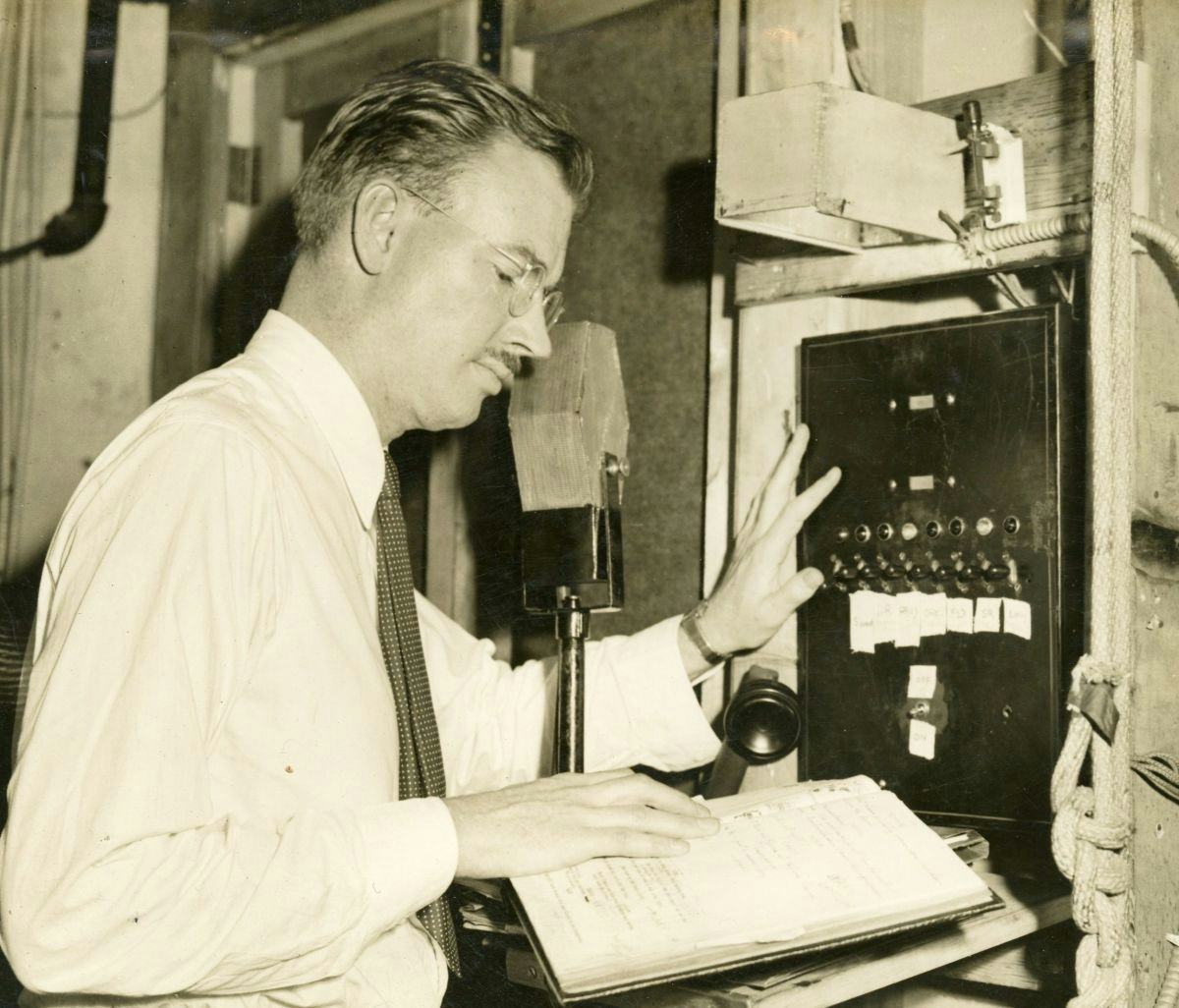Out of the Archives
Harold Burris-Meyer’s controlled sound research helped shape modern entertainment, work and warfare
Imagine watching a spirit glide toward you, its spectral cries growing louder and louder as it comes closer and closer. In May 1934, audiences in The Stevens Theater (now DeBaun Auditorium) were astounded to see the ghost of Hamlet’s father come to life during a sound show — a production showcasing the controlled sound techniques developed by Harold Burris-Meyer, Stevens professor of dramatic arts and director of the Sound Research Department, who taught and conducted research at the university for more than 25 years.
Sound for Entertainment
While the effects in the Hamlet performance may now seem commonplace, Burris-Meyer’s work in sound control — the control of intensity, pitch and timbre of sounds, as well as the apparent distance and direction of sounds — was groundbreaking. An August 1934 article published in Popular Science Monthly raved, “Adapting advanced scientific methods of controlling sound to theater use, Prof. Harold Burris-Meyer recently demonstrated dramatic effects never before attainable.”
The magazine explained the developing technology for readers: “Speech and music that seem to come from any point [within] the theater, as well as mysterious sounds having no identifiable source are produced at will by [careful] combinations of … loudspeakers of diverse types. … During a performance, a sound technician cuts speakers and microphones in or out as required, and handles the maze of jacks, cables and dials that control the complex equipment.”
Burris-Meyer theorized that in addition to creating special effects, controlled sound techniques could evoke moods and emotions. Many of the Stevens Dramatic Society productions he oversaw served as a testing ground for these experiments, using a proto-surround system, dubbed the Stevens Sound Control System. In one of his sound shows, Burris-Meyer used what he called “arbitrary, non-meaningful sound” to capture a character’s descent into madness. The audience was “enabled to hear all of the racket which went on within his brain,” with the intensity of sound increasing as the character’s psychosis progressed.
While Burris-Meyer’s early sound control experiments included casual observations of audience reactions, his research evolved as he sought to measure physiological and psychological reactions stimulated by sound. In a 1935 demonstration at the Yale School of Drama, he debuted subsonics or infrasound (sound with a frequency lower than the limit of human audibility), which he claimed could “make the listener’s bones rattle, teeth ache,” or even “break out into a perspiration of no obvious cause.”
The idea of sound as an invisible, influential force was concerning to some. Following the Yale demonstration, many journalists speculated about nefarious uses of sound, including the potential for mind control or mass hysteria.
Sound for Productivity
The use of sound and music to elicit specific responses in listeners caught the attention of The Muzak Corporation, a company that provided “background music” to offices and factories. Burris-Meyer joined Muzak as a consultant in 1938, studying the physiological and psychological effects of music on industrial workers (he went on to serve as vice president of the company from 1939 to 1947). He sought a formula for “functional music,” to improve mood, boost morale, decrease fatigue and increase productivity.
Burris-Meyer’s observations led to the development of scientifically planned music programs, tailored to many different jobs and listener demographics. Workers would receive an acoustic “dose” of the prescribed music program at specific intervals during their shifts, says Gascia Ouzounian, associate professor of music at the University of Oxford and author of Stereophonica: Sound and Space in Science, Technology, and the Arts, which features a chapter on the work of Burris-Meyer. “Burris-Meyer and Muzak developed a novel form of human systems engineering, where the atmosphere of work — and by extension, the worker — could be controlled by sound on a mass scale.”
Sound as a Weapon
World War II brought the use of new technologies to warfare and raised new scientific questions. The National Defense Research Committee saw an urgent need to understand how sound affects human psychology and physiology. Burris-Meyer was tapped to lead a group of researchers at Stevens to test various uses of sound.
Among other experiments, the group documented the effects of exposing listeners to battle noise — a cacophony of gunfire and explosions meant to imitate the disorienting conditions of combat. For a period of time, the U.S. Navy used battle noise as a screening tool to test the nerve of new recruits. Burris-Meyer was also involved in “Project Polly” — a massive airplane-mounted PA system that could project intelligible speech to people thousands of feet below.
Burris-Meyer’s work in sound control continues to shape our everyday lives. Whenever the seat vibrates beneath you during an IMAX show, you hear nostalgic music at the supermarket, or feel the immersive effects of a videogame soundscape, think of the humble beginnings of these effects in The Stevens Theater. — Compiled by Erin Lewis


